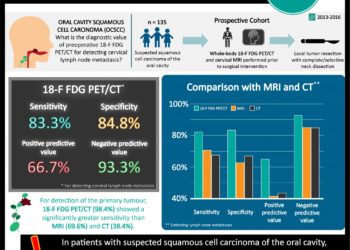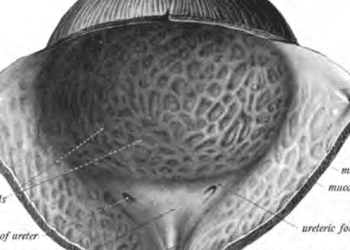Seminal vesicle invasion predicts decreased survival in bladder cancer
1. Concomitant seminal vesicle invasion (cSVI) in patients with urothelial carcinoma of the bladder (UCB) and prostatic stromal infiltration was associated with decreased cancer-specific and overall survival rates.
2. Incorporation of cSVI into multivariate analysis increased accuracy in predicting mortality events.
Evidence Rating Level: 2 (Good)
Study Rundown: In its link to patient outcome, cancer staging is key to determining the most effective treatment courses for patients. For this reason many studies aim to examine physical or molecular readouts from cancer as determinants of patient survival chances prior to assigning aggressive therapies with potentially harsh side effects. Clinical staging often relies on low-invasive methods to evaluate cancer progression. By contrast, surgical/pathological staging of the cancer often includes evaluation of invasion depth from the primary tumor into surrounding tissues. This study examined a particular invasion phenotype, cSVI, in patients suffering from UCB and having undergone radical cystectomy. Currently, cSVI is not an invasion phenotype explicitly considered in evaluating tumor stage by the tumor, node, metastasis classification system. Only patients that also exhibited contiguous prostate infiltration (PI) were considered, as it is generally believed cSVI follows PI. Patients with cSVI were shown to have both decreased cancer-specific survival (CSS) and overall survival (OS) when compared to patients with solely PI. Incorporation of cSVI in multivariate analysis mortality models increased their predictive accuracy. Interestingly, pathological staging revealed clinical staging (using transurethral resection of bladder tumor and computed tomography) to be inaccurately low, with many patients assigned tumor stage cT2 (low amount of invasion). This study was limited by its retrospective nature.
Click to read the study in the Annals of Surgical Oncology
Relevant Reading: Radical Cystectomy for Urothelial Carcinoma of the Bladder Without Neoadjuvant or Adjuvant Therapy: Long-Term Results in 1100 Patients
In-Depth [retrospective cohort]: This study evaluated 385 patients with UCB and PI and without pelvic or abdominal wall invasions or distant metastases. All patients underwent radical cystectomy between 1989 and 2008 followed by routine treatment. Patient follow-up continued until 2011. Cancer-specific mortality and all-cause mortality were evaluated. Patients were divided into two groups based on presence (n = 156) or absence (n = 229) of SVI. CSS and OS events were estimated using the Kaplan-Meier method. Cox univariate and multivariate analysis models were used to calculate hazard ratios (HRs). The effect of SVI on the predictive accuracy of the multivariable models was evaluated using a receiver operating characteristic analysis. It was found that patients with SVI versus without had significantly lower CSS rates (17% vs. 32%; p < 0.001) and OS rates (11% vs. 22%; p < 0.001). Multivariate analysis revealed a number of factors independently affected cancer-specific mortality (CSM), including SVI (HR = 1.69; p < 0.001). SVI was also predictive of increased all-cause mortality (ACM; HR = 1.51; p = 0.002). These findings held true when patients who underwent adjuvant chemotherapy were removed from analysis. Incorporation of SVI into the multivariable models for CSM and ACM resulted in a predictive accuracy gain of 2.3% and 1.9%, respectively.
More from this author: Modulating lymphocyte populations decreases graft rejection in mice,Adding Evolocumab to statin therapy further decreases LDL-C levels,Genetic variant linked to poor patient survival following lung transplantation, Genetic variations may predict outcomes for colorectal cancer patients, Neuroendocrine tumor marker pancreastatin may be predictive of survival
Image: CC/Wiki
©2012-2014 2minutemedicine.com. All rights reserved. No works may be reproduced without expressed written consent from 2minutemedicine.com. Disclaimer: We present factual information directly from peer reviewed medical journals. No post should be construed as medical advice and is not intended as such by the authors, editors, staff or by 2minutemedicine.com. PLEASE SEE A HEALTHCARE PROVIDER IN YOUR AREA IF YOU SEEK MEDICAL ADVICE OF ANY SORT.









